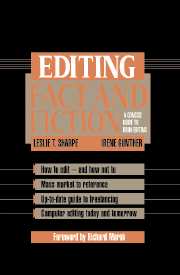Book contents
- Frontmatter
- Contents
- Foreword
- Acknowledgments
- Introduction
- Chapter 1 Who (and What) Is an Editor?
- Chapter 2 Fact or Fiction? Finding Your Niche
- Chapter 3 Principles to Edit By
- Chapter 4 The Editor's Senses
- Chapter 5 The Editor's Sensibility
- Chapter 6 A Guide to Editorial Freelancing
- Chapter 7 Electronic Editing Today and Tomorrow
- Chapter 8 Tools of the Trade and How to Use Them
- Index
Introduction
Published online by Cambridge University Press: 21 September 2009
- Frontmatter
- Contents
- Foreword
- Acknowledgments
- Introduction
- Chapter 1 Who (and What) Is an Editor?
- Chapter 2 Fact or Fiction? Finding Your Niche
- Chapter 3 Principles to Edit By
- Chapter 4 The Editor's Senses
- Chapter 5 The Editor's Sensibility
- Chapter 6 A Guide to Editorial Freelancing
- Chapter 7 Electronic Editing Today and Tomorrow
- Chapter 8 Tools of the Trade and How to Use Them
- Index
Summary
Editing Fact and Fiction is a hands-on guide to book editing. The senior editor will find it useful for its sources and as a training manual for apprentice editors; copyeditors and proofreaders can use it as a refresher course; and for the would-be editor–recent college graduates or someone contemplating a career change–it is a primer of contemporary publishing and editing practices.
Editing is a broad-ranging concept, an art as well as a craft. In crossword puzzles, the word “edit” is the answer to a whole list of clues: review, revise, alter, redact, refine, emend, correct. The craft can be learned fairly easily by diligent attention to the rules of grammar and the conventions of usage and style. To master the art, however, rules are not enough; this mastery requires a special sensibility, a finely tuned ear, and an instinct that comes only with years of experience.
A Good Editor Is Hard to Find
Our basic premise is that every book–whether it's a literary masterpiece, a physics textbook, or a sci-fi novel–deserves the attention of an editor who knows his or her stuff. By “editing,” we mean the art and craft of shaping and refining a manuscript into a publishable book.
But good editing takes time. Unfortunately, in today's publishing environment editors have little time to learn how to edit and even less to do it well. For many senior editors, reading manuscripts and editing the chosen few is a task that must be left to evenings and weekends.
- Type
- Chapter
- Information
- Editing Fact and FictionA Concise Guide to Book Editing, pp. 1 - 7Publisher: Cambridge University PressPrint publication year: 1994

